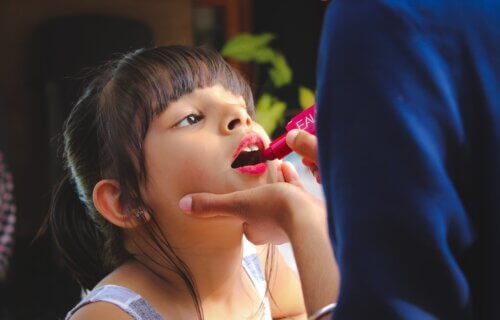NEW YORK — Think twice the next time your child wants face paint for a costume, or some glitter for a party. Unsettling new findings from Columbia University and the non-profit Earthjustice reports the majority of children growing up in the United States use makeup and body products that may contain potentially harmful chemicals and carcinogens like lead and asbestos.
Study authors conducted over 200 surveys and found that 79 percent of parents report their kids (ages 12 and younger) use makeup and body products marketed toward children. More specific examples include glitter, face paint, and lip gloss.
Earlier research warns that these products often contain toxic chemicals like lead, asbestos, PFAS, phthalates, and formaldehyde. Moreover, the toxic chemicals found specifically in kids’ makeup and body products (CMBP), such as heavy metals, appear to be particularly harmful to both infants and children. Such chemicals, whether manufacturers are adding them intentionally or they appear as contaminants, have a link to numerous health problems like cancer, neurodevelopmental harm, and other serious and irreversible health consequences.
“There is increasing evidence of harmful ingredients often included in adult cosmetics and CMBPs, and children are more biologically susceptible to the effects of toxicants,” says study co-first author Eleanor A. Medley, who co-led the study with Kendall E. Kruchten while both completed their MPHs in environmental health sciences at Columbia Mailman, in a university release.
“In this context, it is important to uncover how makeup and body products are being used by children to characterize risk and improve safety,” Kruchten adds.
Which children are using makeup the most?
Among all surveyed children, roughly 54 percent use CMBP on at least a monthly basis. Another 12 percent use CMBP daily, and roughly 20 percent use CMBP for eight hours or more at a time. A third of children even reported unintentionally ingesting the products over the past 12 months. Over a third of the children polled were Latino, with 65 percent of that group reporting CMBP use. Moreover, in comparison to other racial groups, Latino children reported using CMBP more often than any other demographic.
These findings come just as multiple states, such as New York and Washington, have started to consider tightening consumer regulations around toys, makeup, and personal care products.
“Children are particularly vulnerable to adverse health risks associated with chemicals often found in makeup and body products,” explains senior author Julie Herbstman, PhD, professor of environmental health sciences and director of the Columbia Center for Children’s Environmental Health at Columbia University Mailman School of Public Health. “In addition to dermal exposure through the skin, behavioral patterns such as hand-to-mouth activity may increase exposure to products through unintentional ingestion. Additionally, children’s small body size, rapid growth rate, developing tissues and organs, and immature immune systems make them biologically susceptible to the effects of toxicants.”
“It is alarming that industry is being allowed to sell makeup and body products marketed to children that contain extremely toxic chemicals. Findings from this study can help federal agencies better understand how children are using these products and will hopefully spur agencies to act to protect children from toxic chemical exposures,” concludes Earthjustice Attorney Lakendra Barajas. “Unfortunately, currently little is being done at the federal level to protect children from toxic chemicals in children’s makeup and body products.”
The study is published in the International Journal of Environmental Research and Public Health.
You might also be interested in:
- Best Mascaras
- Best Eyeliners
- Best Eyelash Curlers
- Best Lip Balms
- Best Makeup Removers
- Best Nail Polish
- Best Ways to Paint Nails
- Best Way to Paint Toenails

